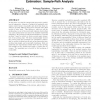IMC
2004
ACM
14 years 5 months ago
2004
ACM
In this paper we explore the current network environment with respect to how the network’s evolution ultimately impacts end-to-end protocols. The traditional end-to-end assumpti...
IMC
2004
ACM
14 years 5 months ago
2004
ACM
We consider the possibility of having a (recursive) name server act as a slave to the root zone, rather than caching information after it is requested. Tests, described here, indi...
IMC
2004
ACM
14 years 5 months ago
2004
ACM
In this paper, we take the sample-path approach in analyzing the asymptotic behavior of single-hop bandwidth estimation under bursty cross-traffic and show that these results are ...
IMC
2004
ACM
14 years 5 months ago
2004
ACM
Monitoring any portion of the Internet address space reveals incessant activity. This holds even when monitoring traffic sent to unused addresses, which we term “background rad...
IMC
2004
ACM
14 years 5 months ago
2004
ACM
The Domain Name System (DNS) is a critical part of the Internet’s infrastructure, and is one of the few examples of a robust, highlyscalable, and operational distributed system....
IMC
2004
ACM
14 years 5 months ago
2004
ACM
For the last few years, large Web content providers interested in improving their scalability and availability have increasingly turned to three techniques: mirroring, content dis...
IMC
2004
ACM
14 years 5 months ago
2004
ACM
Current intrusion detection and prevention systems seek to detect a wide class of network intrusions (e.g., DoS attacks, worms, port scans) at network vantage points. Unfortunatel...
IMC
2004
ACM
14 years 5 months ago
2004
ACM
This paper characterizes the query behavior of peers in a peer-topeer (P2P) file sharing system. In contrast to previous work, which provides various aggregate workload statistics...
IMC
2004
ACM
14 years 5 months ago
2004
ACM
multiQ is a passive capacity measurement tool suitable for largescale studies of Internet path characteristics. It is the first passive tool that discovers the capacity of multip...
IMC
2004
ACM
14 years 5 months ago
2004
ACM
The area of available bandwidth (avail-bw) estimation has attracted significant interest recently, with several estimation techniques and tools developed during the last 2-3 year...




